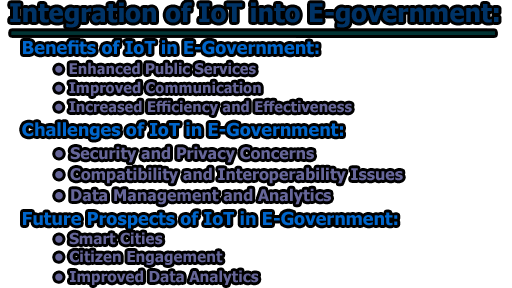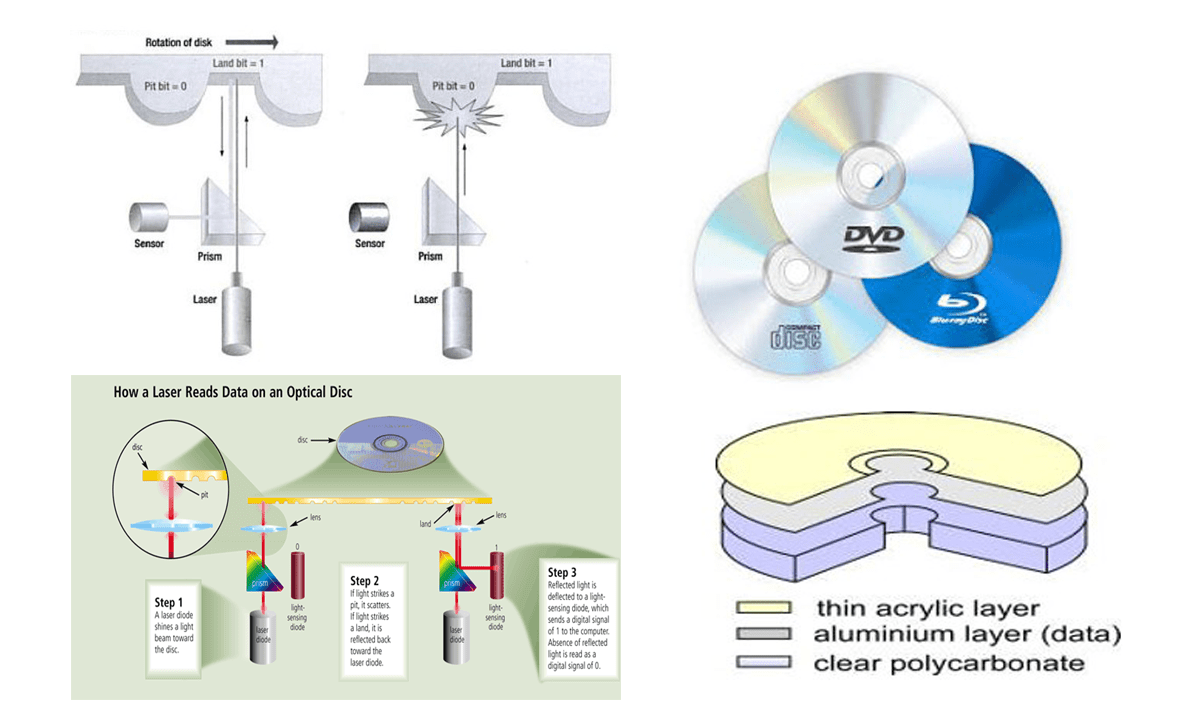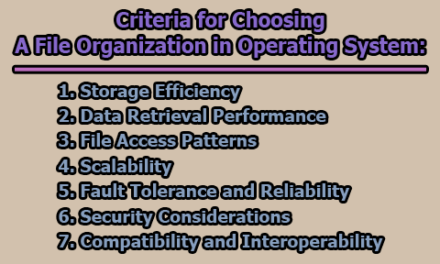Integration of IoT into E-government:
The Internet of Things (IoT) is a rapidly growing technology that connects various physical devices and sensors to the internet, enabling them to exchange data and perform automated actions. In recent years, the IoT has been integrated into many aspects of society, including government operations. The integration of IoT into e-government can enhance the quality of public services, improve communication between government agencies and citizens, and increase the efficiency and effectiveness of government operations. This article will discuss the integration of IoT into e-government and its benefits, challenges, and future prospects.
Benefits of IoT in E-Government:
The integration of IoT into e-government can bring numerous benefits to both government agencies and citizens. Here are some of the most significant benefits of IoT in e-government:
- Enhanced Public Services: The integration of IoT into e-government can improve the quality of public services by providing citizens with more convenient and efficient services. For example, IoT sensors can be used to monitor traffic and parking in real time, allowing the government to optimize traffic flow and parking availability. This can reduce congestion and improve the overall transportation experience for citizens. Similarly, IoT sensors can be used to monitor air quality, weather, and other environmental factors, enabling the government to take proactive measures to protect citizens’ health.
- Improved Communication: The integration of IoT into e-government can improve communication between government agencies and citizens. For example, IoT devices can be used to send real-time alerts and notifications to citizens regarding emergencies, traffic congestion, and other important events. This can improve public safety and enhance citizens’ trust in the government.
- Increased Efficiency and Effectiveness: The integration of IoT into e-government can increase the efficiency and effectiveness of government operations by automating routine tasks and reducing the need for manual intervention. For example, IoT sensors can be used to monitor public facilities such as parks and buildings, allowing the government to identify maintenance needs and allocate resources more efficiently. Similarly, IoT devices can be used to monitor energy consumption and optimize usage, reducing costs and improving sustainability.
- Enhanced Data Collection and Analysis: IoT devices can generate vast amounts of data on various aspects of public services, such as traffic patterns, air quality, and waste management. This data can be analyzed to identify trends, patterns, and insights that can inform policy and decision-making. This can improve the effectiveness of government operations and enhance the overall quality of public services.
- Improved Emergency Response: IoT devices can be used to monitor emergencies, such as natural disasters and public health emergencies, in real time. This can enable government agencies to respond quickly and effectively, minimizing the impact of emergencies and enhancing the overall safety of citizens.
- Increased Efficiency and Cost Savings: IoT devices can automate various aspects of government operations, such as inventory management, supply chain management, and maintenance. This can reduce costs, increase efficiency, and enhance the overall effectiveness of government operations.
- Personalized Services: IoT devices can be used to collect data on citizens’ preferences and behavior, enabling government agencies to provide personalized services and policies that meet their specific needs. This can improve the overall satisfaction of citizens with public services and enhance their engagement with the government.
Challenges of IoT in E-Government:
Despite the numerous benefits that IoT can bring to e-government, there are several challenges that need to be addressed. These include:
- Security and Privacy Concerns: One of the most significant challenges of IoT in e-government is security and privacy concerns. IoT devices are vulnerable to hacking and cyber-attacks, which can compromise sensitive government data and citizen information. The government must implement robust security measures to ensure that IoT devices are protected from unauthorized access and use.
- Infrastructure: IoT devices require a robust and reliable infrastructure to function effectively. This includes a high-speed internet connection, data storage facilities, and energy supply. Governments need to invest in the necessary infrastructure to support IoT devices and ensure their long-term sustainability.
- Compatibility and Interoperability Issues: Another challenge of IoT in e-government is compatibility and interoperability issues. IoT devices and sensors are often developed by different vendors, and they may not be compatible with each other or with existing government systems. The government must ensure that IoT devices and systems are interoperable and compatible with existing systems to avoid disruptions and inefficiencies.
- Skills and Expertise: The successful implementation of IoT in e-government requires a skilled workforce with expertise in areas such as data analytics, cybersecurity, and software development. Governments need to invest in training and development programs to ensure that their workforce has the necessary skills to manage and maintain IoT devices.
- Data Management and Analytics: The integration of IoT into e-government generates vast amounts of data that must be managed and analyzed to derive meaningful insights. The government must have the necessary infrastructure and tools to manage and analyze data effectively, such as data storage, data processing, and data analytics tools. Additionally, the government must ensure that data is collected, processed, and analyzed ethically and in compliance with data privacy laws.
Future Prospects of IoT in E-Government:
The integration of IoT into e-government presents vast opportunities for enhancing the quality of public services, improving communication between government agencies and citizens, and increasing the efficiency and effectiveness of government operations. With the increasing adoption of IoT devices and the availability of advanced analytics tools, the future prospects of IoT in e-government are vast.
- Smart Cities: The integration of IoT into e-government can transform cities into smart cities, where IoT devices and sensors are used to optimize city operations and enhance citizens’ quality of life. For example, IoT sensors can be used to monitor traffic and parking, optimize waste management, and improve public safety. Smart cities can also improve energy efficiency, reduce carbon emissions, and enhance sustainability.
- Citizen Engagement: The integration of IoT into e-government can enhance citizen engagement and participation in government operations. For example, IoT devices can be used to collect feedback and opinions from citizens regarding public services and policies, enabling the government to make data-driven decisions that are more aligned with citizens’ needs and preferences.
- Personalized Services: The integration of IoT into e-government can also enable the government to provide personalized services to citizens. For example, IoT devices can be used to collect data on citizens’ preferences and behavior, enabling the government to tailor services and policies to their specific needs. This can improve the quality of public services and increase citizens’ satisfaction with the government.
- Healthcare: The integration of IoT into e-government can also transform healthcare services by enabling remote patient monitoring and personalized healthcare services. For example, IoT sensors can be used to monitor patients’ vital signs and health status in real time, enabling healthcare professionals to provide timely and personalized interventions. This can improve the quality of healthcare services, reduce healthcare costs, and enhance patient outcomes.
- Disaster Response: The integration of IoT into e-government can also improve disaster response by enabling real-time monitoring of disasters and rapid response to emergencies. For example, IoT devices can be used to monitor weather patterns, seismic activity, and other environmental factors, enabling the government to take proactive measures to mitigate the impact of disasters. Similarly, IoT devices can be used to track the location and status of emergency responders and equipment, enabling the government to deploy resources more efficiently.
- Improved Data Analytics: IoT devices generate vast amounts of data that can be analyzed to improve government operations and public services. Advanced analytics tools, such as machine learning and artificial intelligence, can be used to analyze this data and identify patterns and insights. This can enable the government to make data-driven decisions, improve public services, and enhance the efficiency of government operations.
From the above discussion, we can say that the integration of IoT into e-government can enhance the quality of public services, improve communication between government agencies and citizens, and increase the efficiency and effectiveness of government operations. However, it also presents significant challenges, such as security and privacy concerns, compatibility and interoperability issues, and data management and analytics. To realize the full potential of IoT in e-government, the government must address these challenges and invest in the necessary infrastructure and tools to manage and analyze data effectively. The future prospects of IoT in e-government are vast, ranging from smart cities and personalized services to healthcare and disaster response. As such, the government must continue to explore and invest in IoT to improve the quality of life for citizens and enhance the efficiency and effectiveness of government operations.
References:
- Gubbi, J., Buyya, R., Marusic, S., & Palaniswami, M. (2013). Internet of Things (IoT): A vision, architectural elements, and future directions. Future Generation Computer Systems, 29(7), 1645-1660. doi: 10.1016/j.future.2013.01.010
- Awwad, A. M., Klaib, A. M., & Al-Jaroodi, J. (2017). Internet of Things (IoT) and e-Government: Opportunities and challenges. Proceedings of the 11th International Conference on Innovations in Information Technology, Abu Dhabi, United Arab Emirates, 7-9 November 2017. doi: 10.1109/INNOVATIONS.2017.7880005
- Chen, M., & Li, Y. (2016). Big data for smart city: Infrastructure, framework, and visualization. In Big Data Analytics for Sensor-Network Collected Intelligence (pp. 3-34). Springer International Publishing. doi: 10.1007/978-3-319-30508-5_1
- Wang, L., Teng, J., Ren, J., & Zhang, Y. (2018). Towards smart government through IoT: An architectural perspective. IEEE Communications Magazine, 56(2), 31-37. doi: 10.1109/MCOM.2018.1700368
- Li, Y., Zhang, L., Chen, M., & Sun, X. (2018). Internet of Things for disaster management: State-of-the-art and prospects. IEEE Internet of Things Journal, 5(6), 4376-4390. doi: 10.1109/JIOT.2018.2828625

Library Lecturer at Nurul Amin Degree College










